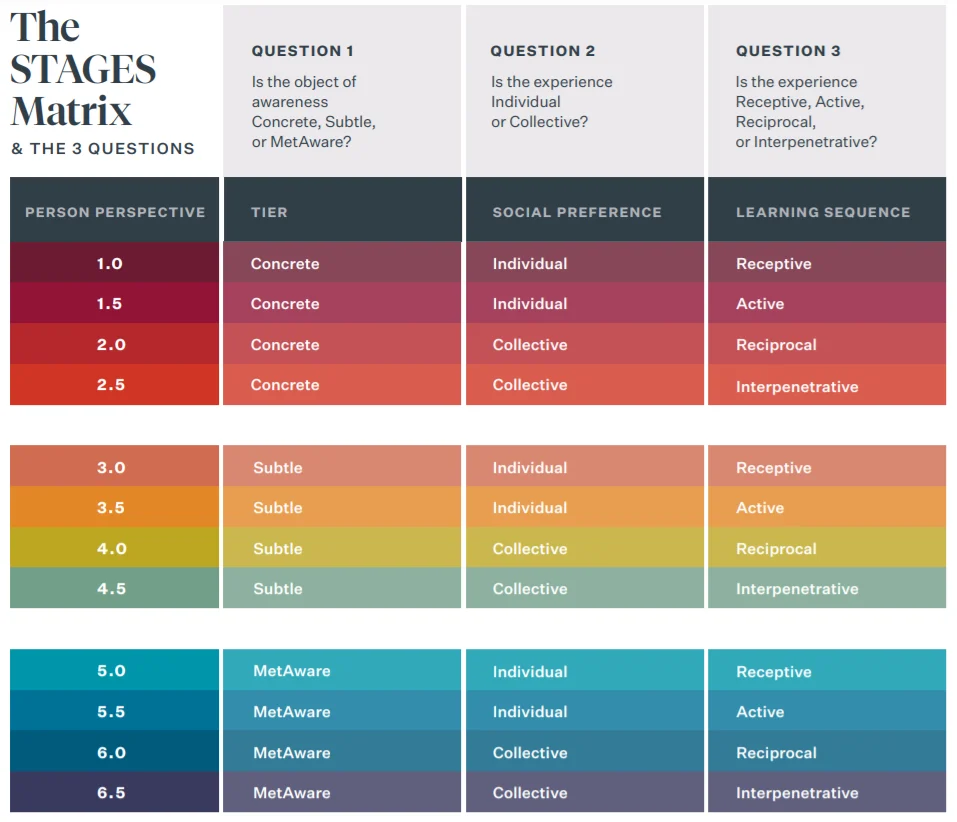Her model extends the work of Suzanne Cook-Greuter’s Ego Development Theory (2005) and Ken Wilber’s Integral Theory (2000), offering a structural and spiritual account of how awareness unfolds through multiple tiers of meaning-making.
Origins of the STAGES Model
O’Fallon traces the roots of her model to three major influences:
- Integral Theory – particularly Wilber’s AQAL framework, which identifies the polarities of individual ↔ collective and interior ↔ exterior.
- Ego Development Theory – introduced to her by Suzanne Cook-Greuter, offering the psychometric base for mapping meaning-making.
- Contemplative Practice – shaped by her association with Father Thomas Keating and the Centering Prayer movement.
During a retreat, O’Fallon experienced what she described as a moment in which “the basics of the ego development model integrated with Ken’s model and with spirituality.” From this synthesis the STAGES Model was born.
She calls herself not the owner but the guardian of the model, noting that it emerged as a gift of insight rather than invention.
Structure of Consciousness Development
The model defines four developmental tiers, each containing four distinct stages—sixteen in total.
- Concrete Tier – sensorimotor and rule-based childhood learning.
- Subtle Tier – complex abstract reasoning typical of adult cognition.
- Metaware Tier – meta-systemic and transpersonal awareness integrating multiple perspectives.
- Unified Tier – non-dual or unitive consciousness glimpsed in advanced contemplative states.
Each stage alternates between individual and collective, and between receptive and active orientations. This rhythmic pattern mirrors the natural oscillation of agency and communion in consciousness (O’Fallon & Brown, 2016, Integral Review).

Boundaries, Social Construction, and Parenting
A central insight in O’Fallon’s model is that boundaries define each stage of development.
In the Concrete Tier, infants and children learn physical and social boundaries—the first structures of selfhood. Parents play a crucial role through touch, language, and emotional attunement.
“We as parents socially construct our children by the rules we put on them, the words we say, and how we react to their emotions.”
— Terri O’Fallon
This idea parallels Berger and Luckmann’s social construction of reality (1966), but O’Fallon places it within a developmental and spiritual frame. Conscious parenting, she suggests, means recognising one’s own inherited boundaries and guiding the child’s growth through healthy containment and freedom.
Horizontal and Vertical Growth — The Balloon Metaphor
O’Fallon uses the balloon metaphor to illustrate balanced development.
Vertical growth describes movement through higher stages, while horizontal growth describes the enrichment of one’s current stage—emotional depth, relational nuance, and sensory refinement.
“If we grow vertically without horizontal depth, we become unstable; if we expand horizontally without transcendence, we stagnate.”
A well-inflated, balanced balloon symbolises integrated growth across all domains: physical, emotional, social, intellectual, and spiritual.
This metaphor echoes Robert Kegan’s (1982) subject–object balance and Ken Wilber’s (2000) principle of transcend and include.
Transformation as a Natural Process
Each movement between stages involves a cycle of disorientation and renewal.
O’Fallon observes:
“Things are falling apart. I’m not the person I used to be, but I don’t yet know who I am.”
Recognising this rhythm helps normalise confusion during transformation. It turns growth into a conscious process rather than an accidental one.
Why Developmental Awareness Matters
The STAGES Model offers both rigour and compassion. It bridges developmental research, integral metatheory, and contemplative practice.
It reminds us that spiritual growth is not a race toward transcendence but a balanced unfolding of all dimensions of being—a continual act of inclusion.
To “grow a balanced balloon at every stage,” as O’Fallon says, is to cultivate awareness, compassion, and resilience as natural expressions of an expanding consciousness.
References
Berger, P. & Luckmann, T. (1966). The Social Construction of Reality. Anchor Books.
Cook-Greuter, S. R. (2005). Ego Development: Nine Levels of Increasing Embrace.
Kegan, R. (1982). The Evolving Self: Problem and Process in Human Development. Harvard University Press.
O’Fallon, T. & Brown, B. (2016). “Stages: Growing up is waking up.” Integral Review, 12(1), 119–151.
O’Fallon, T. & Barta, K. (2019). The STAGES Model: A Full-Spectrum Map of Consciousness. STAGES International.
Wilber, K. (2000). A Theory of Everything: An Integral Vision for Business, Politics, Science and Spirituality. Shambhala.